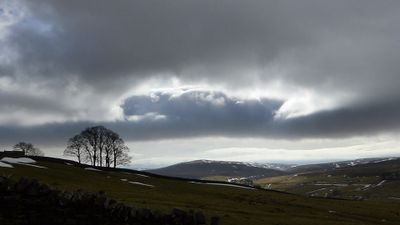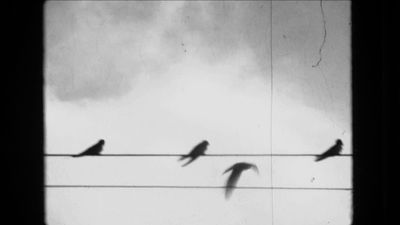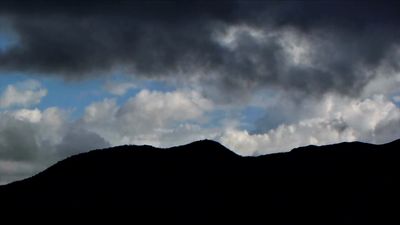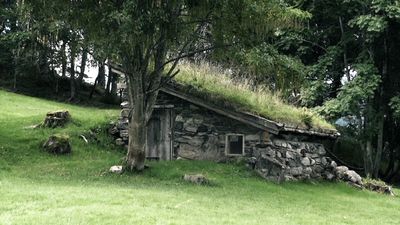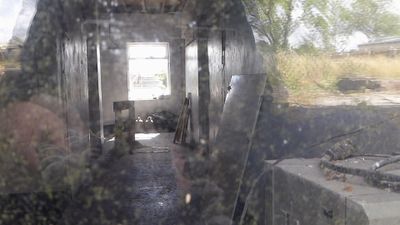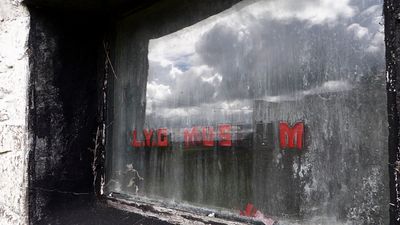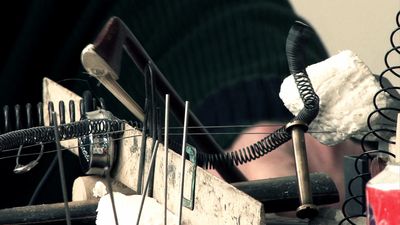Helen Petts
Helen Petts at Kurt Schwitters Merzbarn. © Helen Petts 2011.
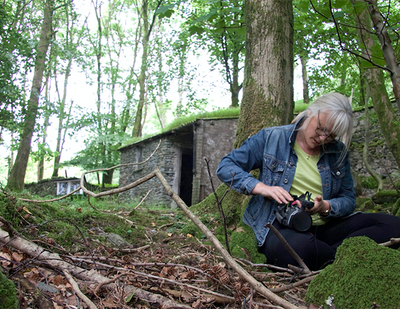
Helen Petts at Kurt Schwitters Merzbarn. © Helen Petts 2011.
The artist-filmmaker Helen Petts is interested in places, traces, textures and sounds. She is known for producing a body of work that makes musical and visual practices visible without falling into the trap of fetishising her subjects. Her films are poetic and painterly, often featuring improvised sounds.
Petts came to filmmaking via community and feminist-oriented video; her collaborative project MsTaken Identity, made with Karen Alexander and Albany Video, was named Best Foreign Video at the 1986 Turin Youth Film Festival. She has also worked as an assistant director of mainstream film drama, and as a television producer and director of arts programmes, including BBC2's The Late Show. She then went on to study fine art at Goldsmith's College, turning to painting with a special focus on minimalism, and returned to video when technology had advanced enough for gadgets to become sufficiently small and lightweight to carry around easily. This allowed her to consider the medium as a form of documenting the sensorial experience of space and sound through film. The Cutty Wren (2008) is a five-minute black-and-white shot of singer Phil Minton performing his own rendition of a 1381 Peasants' Revolt song. Ute on the Marshes (2012) is the black-and-white documentation of vocalist Ute Wassermann testing out the acoustics of the Walthamstow Marshes railway bridge underpass.
In this conversation, which is an edited transcript of a discussion that took place between Petts and myself around a screening at Manchester Art Gallery, Petts talks about how her education in painting has since fed into her approach to film. Petts also introduces Space & Freedom, a film exploring the Taiwanese artist Li Yuan-chia's legacy and relationship with the Cumbrian landscape, where he founded the LYC Museum. The film was commissioned for Manchester Art Gallery's exhibition Speech Acts: Reflection-Imagination-Repetition, which I curated with Kate Jesson (25 May 2018–22 April 2019).
Speech Acts centres on artist Li Yuan-chia's LYC Museum & Art Gallery (1972–1983), and features a stylised reconstruction of the LYC Museum (including its window originally designed and made by artist David Nash). The exhibition examines the role of public museums in telling our collective stories, through the artworks they hold and the exhibitions they arrange; it places work typically considered as 'collection highlights' alongside lesser-known pieces that are seen principally through lenses of biography and difference. The exhibition is part of the research project Black Artists & Modernism, and showcases more than 40 artists drawn primarily from four public collections in Manchester and Bradford.
Space & Freedom was commissioned in this context as an artistic response to Li's legacy, and can be seen as a companion piece to Petts' Throw Them Up and Let Them Sing (2012), a 30-minute looped film installation that follows Kurt Schwitters' journey into exile from Nazi Germany to Norway and Ambleside in the Lake District. The film—which features improvised sounds by leading experimental musicians Phil Minton, Roger Turner, Sylvia Hallett and Adam Bohman—was filmed in places Schwitters loved to go hiking, and was comissioned by the Hatton Gallery in Newcastle to be seen alongside Schwitters' Merz Barn Wall (1947–1948). That Li and Schwitters both based themselves in the Cumbrian countryside suggests a shared investment in place.
HNCould you begin by sharing a little bit about your film response to the life of Kurt Schwitters, Throw Them Up and Let Them Sing?
HPKurt Schwitters was working in Hanover in Germany in the late thirties, and was associated with the Dada movement, but they never allowed him to join because they said he was too bourgeois. He had to escape from Nazi Germany, so he went to Molde in Norway, where he'd been many times before on holiday, and lived on an island in a little hut. When the Nazis invaded Norway in 1940 he went to Scotland, then London, and finally ended up in Ambleside in the Lake District, where he was considered to be a bit of a local eccentric and not really taken seriously.
He had been quite an established artist in Germany. I came across his work in Ambleside, and then by complete coincidence I was invited to Hanover to show some of my work and discovered his much more modernist work than what I'd seen in Ambleside. Basically, my film follows his escape route from Nazi Germany. I got on the same boat on the same route and went up the coast, and then I stayed on the same island. I also stayed in Elterwater, which is a little village near Ambleside where he transformed an old barn into a kind of installation.
The film explores the way that Schwitters related to the landscape. It was commissioned by the Cultural Olympiad for the arts festival of the 2012 Olympic Games. It was shown as an installation at the Hatton Gallery in Newcastle, next to Kurt Schwitters' big piece called Merz Barn Wall (1947–1948). The film then went to Abbot Hall Art Gallery in the Lake District and then to a couple of exhibitions in Norway, later ending up at Tate Britain for the Schwitters in Britain exhibition (30 January–12 May 2013).
HNWhy did you want to make this film, and how did you make it?
HPI was intrigued by the story of Kurt Schwitters' life. I'd been to the Armitt Museum in Ambleside, where there's a documentary that William Feaver made about Schwitters, so I knew the story of his life but it wasn't until Roger Turner, who's the percussionist in the film, loaned me his copy of Schwitters' biography that I thought, 'God, this is really fascinating.' I'd only seen what I call the 'chocolate box pictures' in Ambleside, which are the kind of commercial paintings he made for money.
I went and checked out the Sprengel Museum in Hanover, where the Schwitters Archive is and was blown away when I saw the collages—I kind of felt that he was speaking my language. I spoke to a wonderful artist called Jefford Horrigan, who had a studio beneath me at the time, about the idea of going to Ambleside and then to Hanover and he said you have to make a film about this. I kind of wanted an excuse to go to Norway because I'm convinced that I'm a Viking [laughs] and I had never been to Norway. And I have this passion for wild mountainous landscapes and hiking.
HNWas it also a kind of pilgrimage?
HPOh yeah. And I just fell in love with the guy—I just wanted to follow the route he'd gone. A lot of the shots in the film are reproductions of photographs. I went to the Victoria and Albert Museum, to the National Art Library, and just sat and went through the catalogue raisonné. There were lots of photographs of him wearing walking boots and many drawings of landscapes—I worked out from a map where the walks were.
It was like a pilgrimage, I guess; and to be honest the Cultural Olympiad were looking for projects and I thought this would be one that they might be interested in. By an amazing fluke, two of the people who sat on the committee that assessed it were really big Schwitters fans. They came from an opera background and they knew about the Ursonate, which is the experimental vocal piece that Schwitters used to perform at parties and events. The Hatton Gallery is the home of the Merz Barn Wall, which is Schwitters' most famous piece. It's a wall from his barn that he created in Elterwater and it was disintegrating so in the early sixties it was moved to Newcastle University's art gallery, the Hatton Gallery, and it's still there.
HNYou actually spent a few weeks in Norway living in isolation, right?
HPYeah. The hut in Norway is on Hjertøya Island in Moldefjord, where there are a number of traditional Norwegian houses. Nobody lives there; the old wooden houses have been transported and put on that island, and it's only open for two months of the year. I went there in August when it's closed, because August is like autumn in Norway. It's quite northern so it was completely empty, and I had the island to myself for a week. I was given a really nice little holiday cottage and I got up at dawn every morning and just watched and listened to the birds and recorded the sounds and filmed the light and the reflections and really felt his presence. Maybe I'm just being a daft romantic, but I was never lonely for a moment. I totally felt like he was there with me [laughs].
HNThe film ends with a scene of you with a tiny camera. Is that the camera that you filmed most of this with? What is the significance of the size of the camera?
HPIt's an old Panasonic Lumix that allows you to go from macro to wide angle all in one shot. I don't hold the camera; I have it on a monopod and I kind of dance with it. I've filmed a lot of musicians with it, going very close on their fingertips.
My work would not exist if there hadn't been such an amazing improvement in the quality of video footage shot on tiny cameras—it's the technical specificity of these kinds of cameras that have allowed me to do what I want to do. It's also just so much more portable and I tend to like to go on a journey and see what happens with chance events, such as the thunderstorm in the film. It started to rain and I went into a cave to shelter—and a crow appeared. And that is the cave that Schwitters and Wanty, his girlfriend, used to go to for picnics. I had a lovely encounter with the woman who was responsible for rescuing a lot of Schwitters' work, Mary Burkett, who was the first director of Abbot Hall Gallery in Kendal, and she told me they used to go for picnics there, so I had already been by accident but fortunately it turned out to be quite appropriate.
HNYour mode of working is very much in conversation with the improvised chance collage aesthetic of Schwitters. But also behind us on this slide are two of your early paintings from when you were studying fine art at Goldsmiths.
To my eyes, when I compare Throw Them Up and Let Them Sing and Space & Freedom, the films in Speech Acts both have a painterly quality to them. In your framing and editing, one can see your engagement with the genres of painting: landscape but also elements of still life, portraiture, and abstraction. How did you develop this approach to making film?
HPI've just noticed now that there are a lot of diagonals in my work—I've got a thing about diagonal lines. I worked in a gallery that specialises in minimalism, so I think that was an influence. This [pointing at a slide of abstract painting] is my graduation show at Goldsmiths.
I started out making films in my twenties as a sort of feminist community video activist. My first piece was about being a teenage girl. I was about 23 and I was working on a youth project. I then went on to work in television and made youth programmes and arts programmes, but I was in a road accident that sort of ended all that so I then went to Goldsmiths as a mature student and these abstract paintings is what I did and they hated it, because I went there in the aftermath of YBAs and this was like ...
HNReactionary.
HPYes, this [pointing at an image of her painting] is really reactionary. This is Greenbergian formalism that was considered to be the ultimate in masculine heroic painting. I kept saying, 'yeah but I used to make feminist films, I got my credentials there; this is what I want to make now.' I look at the paintings that I did then and I think they're all about surface and texture—I used wax and pigment and I'm interested in what happens when you scrape away and leave a trace of pigment on the smooth white surface of gesso, and use big brushes to sort of wipe out the image and then erase edges of the image. It is similar to the images that I get with this tiny camera, which is great at macro shots, so you can go in close on a piece of bark and get a similar texture.
HNIs that something that you're consciously looking for?
HPNo [laughs]. It's only looking at the paintings now with you that I see the links between them and the films and with the sound. The scratchiness in the sound is similar to this process of scratching and erasing in the image.
HNThere was a lovely piece that David Briers wrote on Throw Them Up and Let Them Sing in Art Monthly back in 2012, and he pointed out very astutely that, just like John Cage inspired visual artists, Schwitters has inspired composers.
HPWhen I left Goldsmiths I was doing these very solitary paintings, and then I had a bit of a crisis because my partner died and I couldn't be in the studio alone any more. So I started going to gigs and filming the musicians, partly because I was broke and if I filmed them I got in for nothing. It was the early days of the internet and I was sort of one of the first people to put decent stuff on YouTube, and I was recording good quality sound as well. I met a lot of musicians in a particular area of music called free improvisation, which seemed to speak the same language as my paintings. The way I filmed those musicians developed, especially with Roger Turner. I got closer and closer and more abstract in order to concentrate on the rhythms he was creating with his fingers, with objects such as a plastic fork or a cymbal, and the shadows that that plastic fork would form.
HNSo, Roger Turner was the man who was playing your brushes and your palette knives.
HPYes. And he's the man who lent me the Schwitters book, I mean he kind of introduced me to Schwitters' work, really.
HNWe also saw Sylvia Hallett in that memorable opening scene which looks like she is playing a bicycle wheel?
HPYes it is. She plays a bicycle wheel and the sound goes through electronics. I had made films with her before but I knew it was the sound of empty fjords and perfect for those scenes. She also plays the Norwegian hardanger fiddle in a later scene. And Schwitters made a lot of works with bicycle wheels.
HNIn another scene in Throw Them Up and Let Them Sing, Adam Bohman is playing what looks like hardware.
HPYeah, he's creating sounds using found objects with contact mics attached to them. When I was in the tiny hut on the island in Norway, and it was kind of windy outside and squeaking a bit I thought: 'Adam Bohman makes the sounds that this hut would make if it were a musical instrument'. So when I got back home, I got him to improvise something to the rushes, which I then edited to. I always work that way round.
HNThere are many structural and visual similarities between Throw Them Up and Let Them Sing and your new film Space & Freedom, but I would like to focus on the differences. The first sequence in Space & Freedom is not actually your footage: it's an archival shot by Li Yuan-chia that you came across at the John Rylands Library. Would it be fair to say that your use of archival footage is the single biggest difference between the two films?
HPSadly, there is very little left to film of Li Yuan-chia at his house in Cumbria, which is now empty and very derelict. But fortunately he had done a lot of work with film and video in the later years of his life and I got permission from the LYC Foundation to use it. At the time, everybody thought that there were no sound recordings. When I went to the John Rylands Library and went through the catalogue I saw it said 'reel-to-reel tape', and I think the people who had done the archive research before didn't realise that meant sound. I brought it to London and took it to Dave Hunt, who's the sound engineer that I work with, and we got it on his big reel-to-reel tape recorder and found that there was some sound; that Lee had actually recorded his plans for converting this derelict old house into a museum. It sounds as if he was alone when he was recording this and was obviously doing it for somebody in the future to do something with. I'm getting goose pimples when I say this, because I just couldn't believe it when I found it.
HNAnd it's not just sound, there's also a video where he seems to be part performing for the camera as he is constructing the museum and showing it functioning.
HPIn the later video footage, he's making a record of what he's done, that's at the end of his life—he's much older when he did that. And also there's the sound of him whistling and I've put that together with his own archival film footage of birds, and layered it and repeated it to go with his whistling. I can't stress how grateful I am to everybody at the Li Yuan-chia Foundation and the John Rylands Library to have allowed me access to do that—it felt like an extraordinary responsibility.
There are two Taiwanese archivists, Kaiwei Wang and Wei Yu, who have been working for five years cataloguing all of Li's work and they came around to my house and listened to the voice recording after I found it. Kaiwei just burst into tears and said, 'I've been working with his archive for five years and I'd never heard his voice before.' It was acutely gratifying to get that response.
HNWas it a conscious decision of yours to focus on places that record traces of an individual's existence as the subject, rather than the individuals themselves or indeed their artwork?
HPYes. Well, both films are about places where there is a sort of trace of previous artistic presence—and I didn't feel it that much the first time I went to Bankside, where Li's museum is. But the second time I went, I felt it more.
I knew Li was very interested in contemporary avant-garde classical music: he made many recordings of a BBC programme called Music of Our Time. Li's voice recording was recorded over one of these programmes, which is why the quality is so bad, as it did not completely erase the piano music underneath. So the voice recording is really bad quality but I've kind of made a feature of it. It's like pentimento in painting really. But it let me know Li's taste in music so I asked Steve Beresford, who's the person who pretty much introduced me to most of the musicians I know, to improvise prepared piano pieces that punctuate the images. It adds another atmosphere to it. I worked with him when I was a television director and we've stayed friends ever since. He's a leading authority on free improvisation but also performs John Cage's piece 'Indeterminancy'.
HNRegarding the idea of the trace, are these two films memorials of some kind? And if so, what kind of memorials are they? Memorials have been called 'a promise to the future about the past'—does that resonate with you?
HPI suppose it's my personal memorial. Lots of people have made work in response to Kurt Schwitters—he's inspired lots and lots of artists. I wasn't thinking I was doing anything that hadn't been done before, but I think I was the first person to compare the landscapes of Cumbria and Norway.
HNBut in a way it's in the spirit of musical improvisation—it's a sort of a call and response.
HPYeah. Both films are very much influenced by improvisation—the whole way I work is. I respond to what I find on the day, in the moment when I'm travelling. I've got certain health problems, so it is totally impossible to plan what I do from one day to the next. I used to work with film crews and make arts documentaries for TV but I can't do that any more because I never know how much energy I'll have. So I just set out with equipment that gets smaller and smaller every year and just respond to what happens in front of me. Both films were made in that spirit and I think both those artists worked in that spirit as well, and that's probably why I've chosen them.
One note on the titles: both are quotes from the artists. Schwitters said when he made his collages he took the raw materials and would just 'throw them up and let them sing'. When Li Yuan-chia left the London art scene in 1967, where he was quite a successful artist, for Banks in Cumbria he said he was going in search of 'space and freedom'.—[O]


